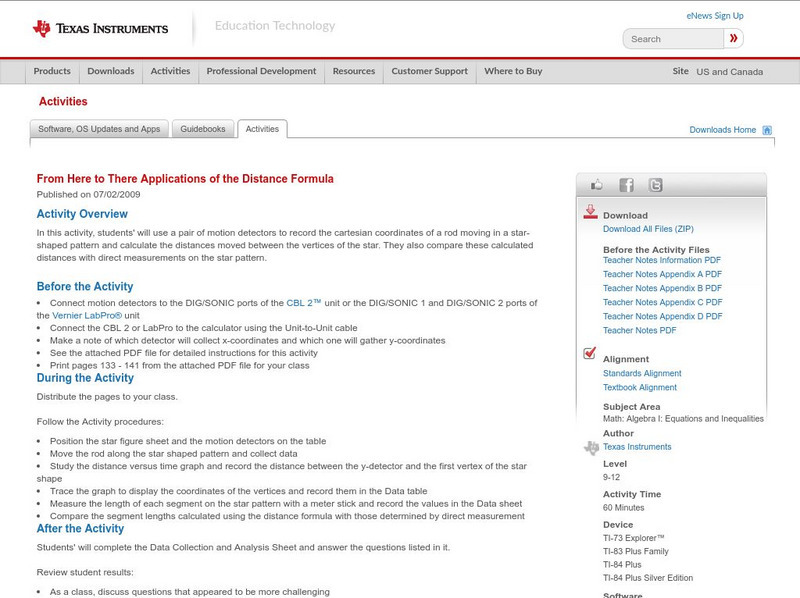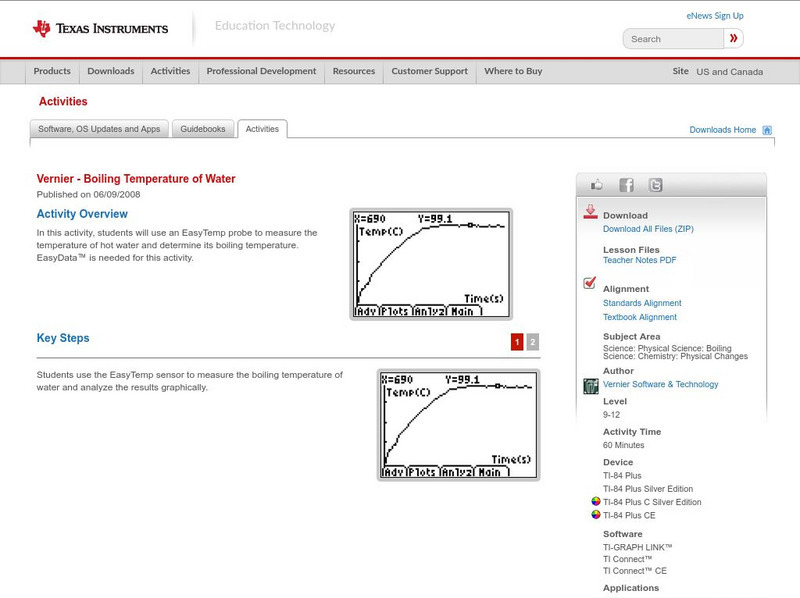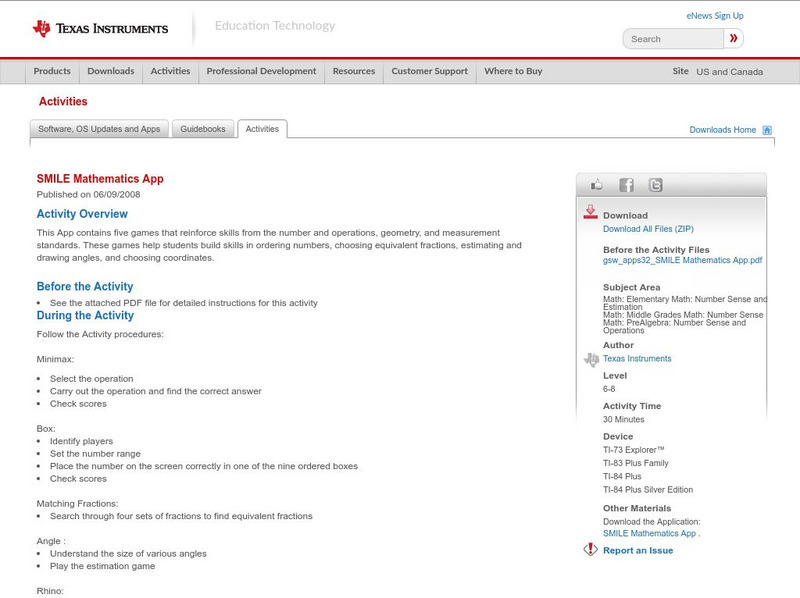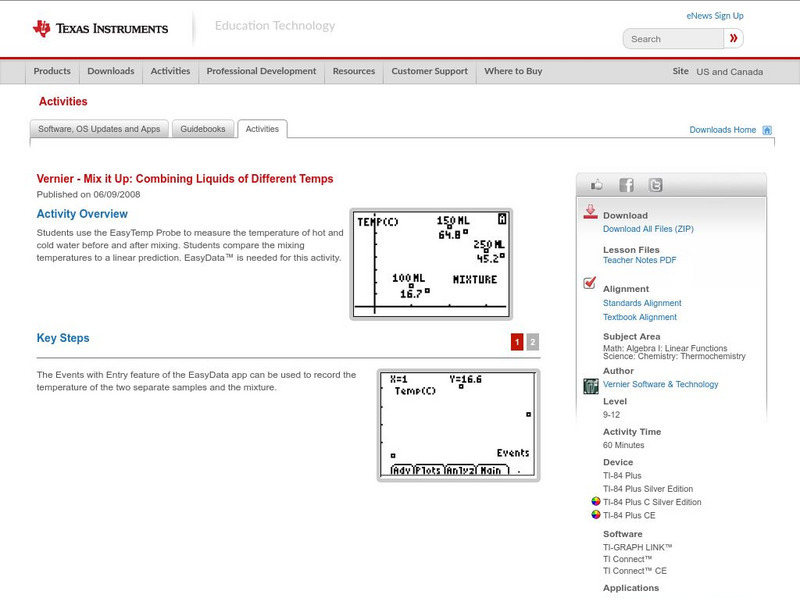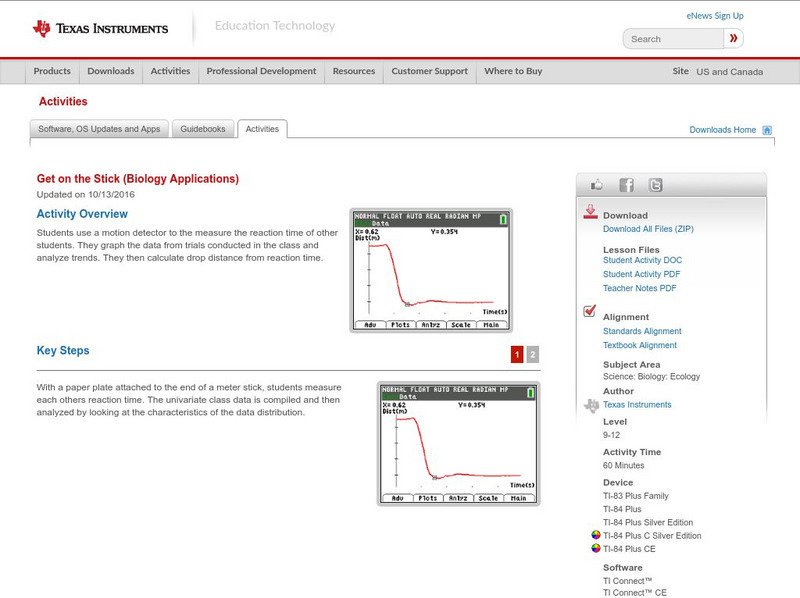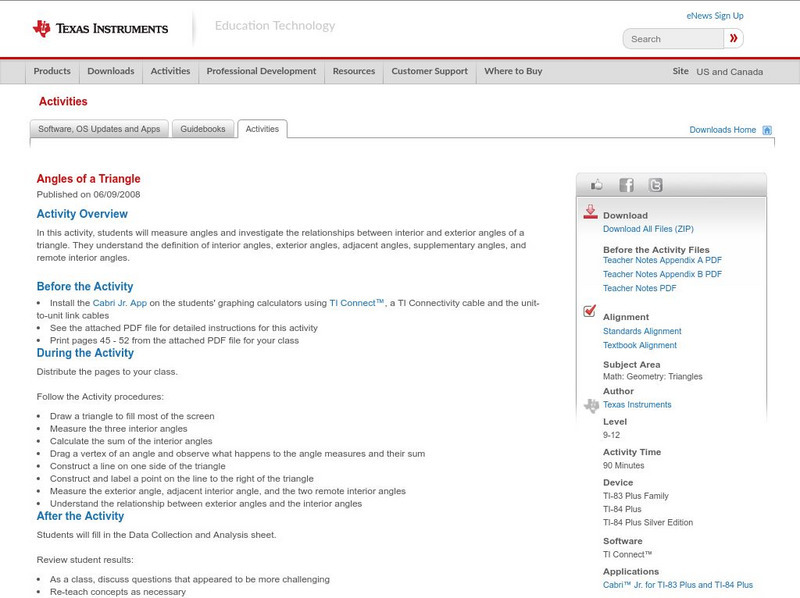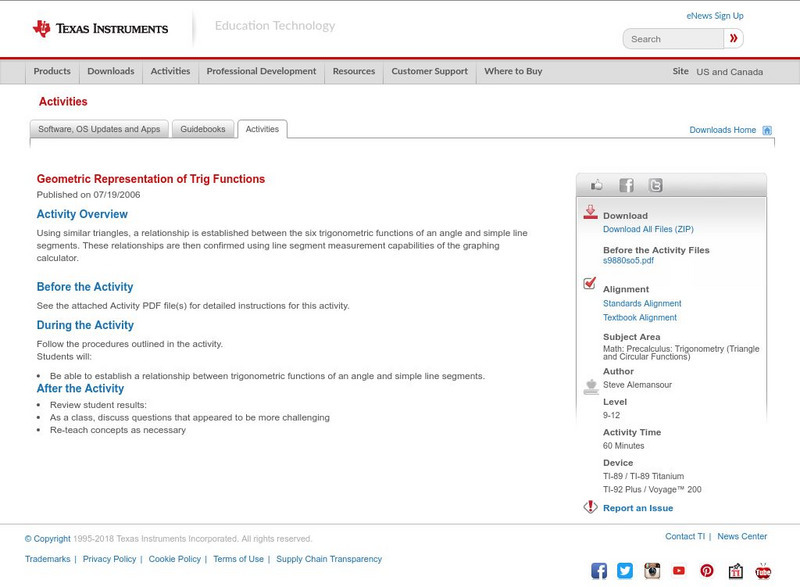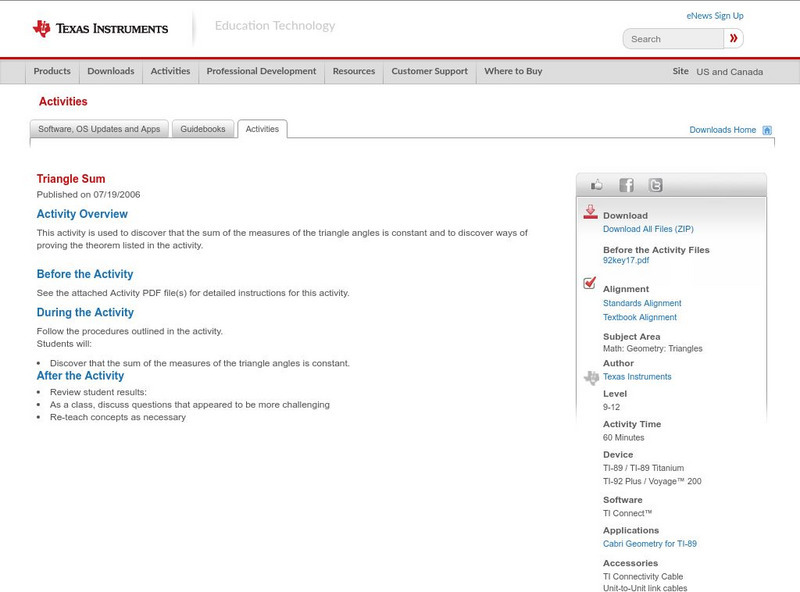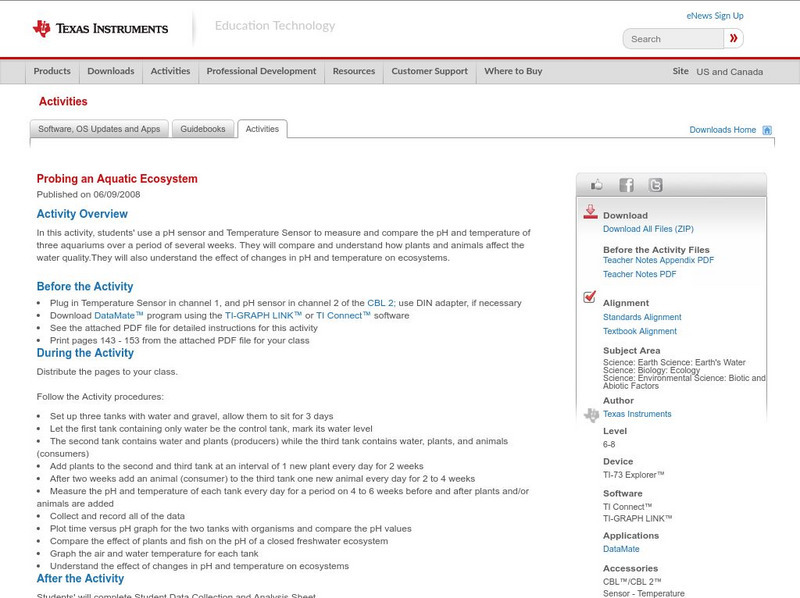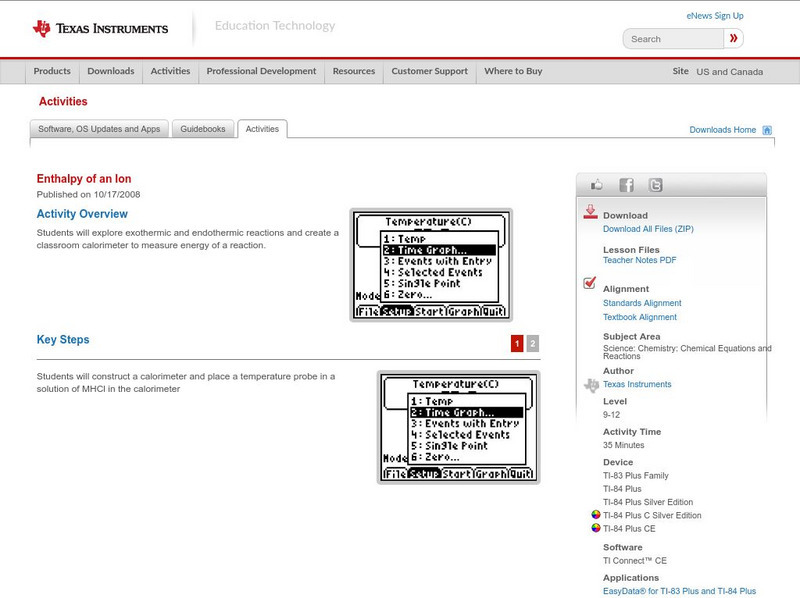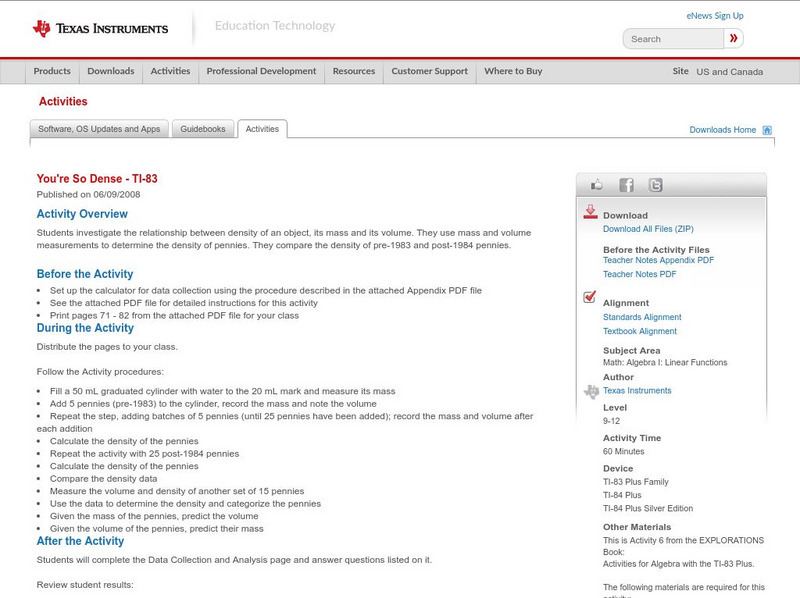Texas Instruments
Texas Instruments: An Inclined Plane
In this activity, Students can use a Force Sensor to measure the force needed to lift an object and the force needed to pull the same object up an inclined plane. They will also calculate work done and efficiency and make conclusions.
Texas Instruments
Texas Instruments: From Here to There Applications of the Distance Formula
In this activity, students' will use a pair of motion detectors to record the cartesian coordinates of a rod moving in a star-shaped pattern and calculate the distances moved between the vertices of the star. They also compare these...
Texas Instruments
Texas Instruments: Acid Rain
Students use the pH sensor to measure changes in the pH when CO2 dissolves in water. They also study the changes in the pH when sulphuric acid is added to water and identify water bodies most likely to be affected by acid rain.
Texas Instruments
Texas Instruments: Voltage From Dry Cells
In this activity, students can use a voltage sensor to measure the voltage produced by new dry cells of each size. They will also determine whether there is a relationship between dry cell size and voltage.
Texas Instruments
Texas Instruments: Designing Hot and Cold Packs
in this activity, students calculate the molar enthalpy of dissolving for three ionic solids, and use this information to design a cold pack. In this experiment they measure the heat changes which occur from various salts dissolving in...
Texas Instruments
Texas Instruments: Boiling Temperature of Water
In this activity, students can use an EasyTemp probe to measure the temperature of hot water and determine its boiling temperature. EasyData is needed for this activity.
Texas Instruments
Texas Instruments: Smile Mathematics App
This App contains five games that reinforce skills from the number and operations, geometry, and measurement standards. These games help students build skills in ordering numbers, choosing equivalent fractions, estimating and drawing...
Texas Instruments
Texas Instruments: Estimating and Finding Confidence Intervals
In this activity, students estimate statistical measures and find confidence intervals.
Texas Instruments
Texas Instruments: Mix It Up: Combining Liquids of Different Temps
Students use the EasyTemp Probe to measure the temperature of hot and cold water before and after mixing. Students compare the mixing temperatures to a linear prediction. EasyData is needed for this activity.
Texas Instruments
Texas Instruments: Heart Rate and Body Position
In this activity, students can use a Heart Rate Monitor to measure their heart rate while sitting, lying down, and standing. They will analyze the data collected to determine the effect of body position on heart rate.
Texas Instruments
Texas Instruments: Get on the Stick
In this activity, students' use a motion detector to the measure the reaction time of students. They graph the data from trials conducted in the class and analyze trends. They then calculate drop distance from reaction time.
Texas Instruments
Texas Instruments: Angles of a Triangle
In this activity, students will measure angles and investigate the relationships between interior and exterior angles of a triangle. They understand the definition of interior angles, exterior angles, adjacent angles, supplementary...
Texas Instruments
Texas Instruments: How Tall? Describing Data With Statistical Plots
In this activity, students' will measure their heights using a motion detector and describe the data using the statistical concept called box plot.
Texas Instruments
Texas Instruments: Jason: When P H Changes, What Happens?
JASON Aquatic Field Study: Explore how the pH of an aquatic site determines if the water is acidic, basic, or neutral by performing an experiment at a local aquatic site to measure the pH level.
Texas Instruments
Texas Instruments: Falling Objects
In this activity, Students can use a Motion Detector to measure distance and velocity.
Texas Instruments
Texas Instruments: Geometric Representation of Trig Functions
Using similar triangles, a relationship is established between the six trigonometric functions of an angle and simple line segments. These relationships are then confirmed using line segment measurement capabilities of the graphing...
Texas Instruments
Texas Instruments: Maximizing the Area of a Rectangle
This activity is adapted from one of the TI books. Students measure lengths and widths of rectangles and record for the class to see. Each group's rectangle has the same perimeter, but different areas. After a discussion, students make...
Texas Instruments
Texas Instruments: Triangle Sum
This activity is used to discover that the sum of the measures of the triangle angles is constant and to discover ways of proving the theorem listed in the activity.
Texas Instruments
Texas Instruments: Probing an Aquatic Ecosystem
In this activity, students' use a pH sensor and Temperature Sensor to measure and compare the pH and temperature of three aquariums over a period of several weeks. They will compare and understand how plants and animals affect the water...
Texas Instruments
Texas Instruments: Jason: How Dense Is Salt Water?
Disappearing Wetlands: Explore the relationship between mass, density, and salinity by measuring the mass and volume of four saltwater solutions of increasing strength.
Texas Instruments
Texas Instruments: Enthalpy of an Ion
In this activity you will: Explore exothemic and endothermic reactions. Create a classroom calorimeter to measure energy of a reaction.
Texas Instruments
Texas Instruments: Perpendicular Bisector Theorem
This activity uses distance measures to investigate the relationship between a point in the plane and the distance to the endpoints of a segment. Students will investigate the implication these relationships have for the position of the...
Texas Instruments
Texas Instruments: You're So Dense Ti 83
Students investigate the relationship between density of an object, its mass and its volume. They use mass and volume measurements to determine the density of pennies. They compare the density of pre-1983 and post-1984 pennies.
Texas Instruments
Texas Instruments: Comparing Sunscreens
In this activity, students use the UVB Sensor to measure the amount of UVB light that passes through a thin film of sunscreen. They analyze the relationship between the SPF values and the intensity of UVB light transmitted by the sunscreen.



